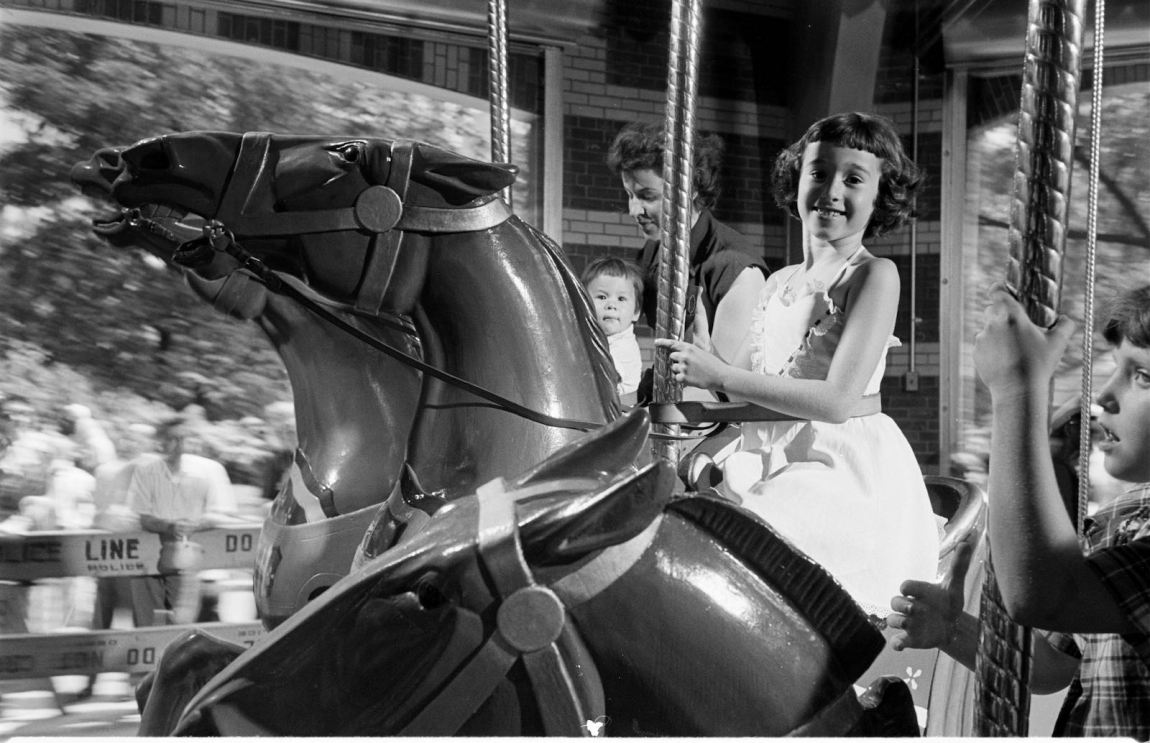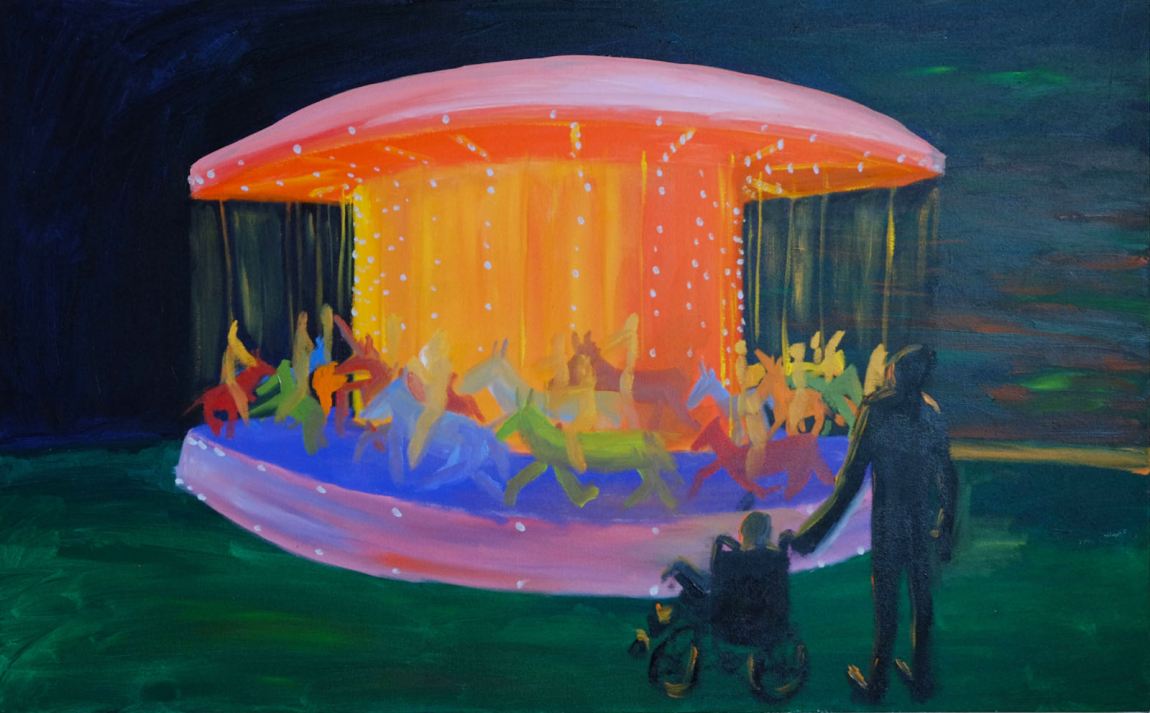On January 13, in response to the deadly insurrection at the US Capitol, New York City mayor Bill de Blasio announced that the city was terminating its contract with the Trump Organization to manage, along with two skating rinks and a golf course, the Central Park Carousel. For ten years, the Trump conglomerate has raked in money from the carousel, one of the largest in the United States. First installed in 1951, after two previous iterations had burned down, and featuring fifty-seven hand-carved horses, two chariots, and a barrel organ that pumps out waltzes and polkas, it is said to attract some 250,000 riders annually. Eric Trump called the mayor’s announcement yet another example of “cancel culture.” You launch a coup and before you know it, they’re canceling your carousel contract.
It’s disheartening to think that Donald Trump had profited from a carousel so rooted in the American imagination. In the culminating scene in The Catcher in the Rye, Holden Caulfield, alienated from his family, meets his ten-year-old sister, Phoebe, for a walk in Central Park, and watches her ride the carousel on a “big, brown, beat-up-looking old horse.” Feeling an inexpressible happiness—“It was just that she looked so damn nice, the way she kept going around and around, in her blue coat and all”—Holden embraces the momentous decision to return home.
And yet, it would appear—from the 1951 publication date of the novel and from the condition of the beat-up-looking old horse—that Phoebe is riding on the carousel that went up in flames in 1950, and not Trump’s later version, which was rescued from a trolley terminal in Coney Island and reassembled in its current setting in Central Park.
I was surprised to learn that Rainer Maria Rilke’s nostalgic poem “The Carousel” may well have been a source for Salinger’s Central Park scene. Rilke evokes, in Edward Snow’s translation, “this little herd/of many-colored horses, all from the land”—the land of childhood, presumably—“that lingers long then disappears.” The horses skim past along with “girls in bright dresses…almost too old/already for this leaping of horses.” The scholar Dennis McCort, who notes that Salinger was a great admirer of Rilke, sees a direct connection between one of those girls in bright dresses, Rilke’s blaues Mädchen (little girl in blue), and blue-clad Phoebe.
On a recent trip to Paris, I made a big deal of showing the carousel that had inspired Rilke to my wife and our two adult sons (one of whom, Nick, had painted an evocative picture of one). We were walking through the Jardin des Plantes after visiting the nearby Rodin Museum. I explained that the carousel at the edge of the garden figured in Rilke’s poem “Pont du Carousel,” and that Rilke had written the poem when he was serving as Rodin’s secretary and writing his “thing poems,” collected in two volumes of New Poems (1907–1908), inspired by the materiality, the “thingness,” of Rodin’s creations.
Pretty much every detail in this fluent stream of mansplaining turned out to be wrong, however. Rilke did write a poem about a carousel, but it’s not “Pont du Carousel,” which is about a blind man on a bridge. His “Das Karussell” was written several years after the New Poems, and the carousel was in the Jardin du Luxembourg, not the Jardin des Plantes.
I did remember the refrain of the poem, though. There was a professor of German at Harvard back in the 1970s, when I was first reading Rilke, who wore white sneakers to work. Whenever he walked by, grad students would whisper, “Und dann und wann ein weisser Elefant.” The words—“and now and then a white elephant”—are a recurring line in Rilke’s “Carousel.”
I myself helplessly associate carousels with the 1945 Rodgers and Hammerstein musical set among carnies and millworkers in Maine. The first time I played viola in an orchestra pit was in 1968, when the Richmond Civic Theatre, in Indiana, mounted a production of Carousel. The opening waltz, which is meant to sound like a carousel organ, still kills me. It is playing when the carnival barker Billy Bigelow first puts his arm around Julie Jordan during a ride on the carousel he runs. For thirteen-year-old me, this was the height of romance. I was also stirred by “You’ll Never Walk Alone,” which Julie’s cousin sings to console her after Billy’s suicide following a botched robbery.
“You’ll Never Walk Alone” received an unexpected boost amid the Covid-19 crisis. According to the BBC, the Merseybeat version covered by Gerry and the Pacemakers, a number one hit in the UK in 1963, also topped a chart on the “lockdown listening list” last March, based on increased demand on streaming services. The Pacemakers’ version is the official song of Liverpool Football Club. Gerry Marsden, the band’s leader and a Liverpool native, died on January 3, 2021 (after a short illness not connected to the pandemic).
Advertisement
In novels, poems, and musicals, carousels are often deeply tied to the human life cycle, redolent of the relentless passing of time and childhood nostalgia. As an attendant at the Central Park Carousel named Sal Napolitano told The New York Times back in 2009:
First you go in the chariot or on a horse that doesn’t go up and down. There are 53 that move, and four are stationary. Then you go up and down with your parents. Then your parents watch from outside. When they’re teenagers I don’t see them because they’re too big for the carousel. Then they come back with their boyfriends and girlfriends. And then with their children. It’s like a circle.
Joni Mitchell could hardly have said it better. We’re all “captive on the carousel of time.”
But do carousels themselves have a life span? In an age of virtual reality, are these devices of nineteenth-century machinery an endangered species? A 113-year-old carousel in a park in Tokyo, as Motoko Rich reports in the Times, has been disassembled to make way for a Harry Potter theme park. According to Patrick Wentzel, president of the preservationist National Carousel Association, the Tokyo carousel—which started its life in Germany and (rather like its Central Park counterpart) was moved to Coney Island before landing in Japan—is one of only about a dozen of its kind, in age and size, remaining in the world. Now that Trump has been banished from both the political and the physical merry-go-round, will someone else come forward to run the Central Park carousel—“this little herd of many-colored horses, all from the land that lingers long then disappears”?




